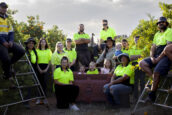
Chocolate eggs feature heavily in Easter celebrations but there is a dark side to the bunny’s bounty. Louise Heinrich uncovers some realities of the chocolate industry that will leave a bad taste in your mouth.
In my life, Easter means a meal with my family, a contemplative church service and lots of chocolate (peppermint’s my favourite — if you feel like buying me a gift this year).
But my decadent affection for the cocoa bean has been affronted by a new social conscience after learning about the less-than-delicious centre of chocolate production: most Australian chocolate contains some cocoa from West Africa, where there are thousands of trafficked children picking the cocoa beans.
That section of the African continent, encompassing Ghana, Nigeria, Côte d’Ivoire and Cameroon, is the source of 70 per cent of the world’s chocolate. US government sources estimate that some 10,000 children are victims of human trafficking or enslavement in Côte d’Ivoire alone.
As well as working in horrific circumstances, many cocoa bean pickers experience other aspects of slavery: torture, cruelty, loss of free will and the shattering of selfhood.
In Modern Slavery, a 2009 documentary on forced labour around the world, Noam Chomsky declared, “A lot of people are responsible but the question we should be asking is, ‘To what extent are we responsible?’”
Carolyn Kitto, Coordinator of Stop the Traffik Australia, said, “We are held accountable, not just for the things that we do wrong but also for the situations where we failed to do what is right.”
Stop the Traffik is an international organisation dedicated to ending human trafficking around the world, particularly through empowering individuals to combat slavery — personally.
“In his theology of liberation Jurgen Moltmann said, ‘Oppression has two sides: on one side there is the master, on the other side the slave. Oppression destroys humanity on both sides,’” Ms Kitto said.
“To campaign within an industry where there is oppression in the supply chain helps liberate the culture of the company — and those who purchase their products,” she said.
As well as working in horrific circumstances, many cocoa bean pickers experience other aspects of slavery: torture, cruelty, loss of free will and the shattering of selfhood.
But change in the chocolate industry is agonisingly slow.
In 2001, major companies such as Mars and Cadbury signed up to put an end to trafficking by putting one product through accreditation. However, they were only token gestures and there is a long road ahead.
It is up to public pressure from individuals like us to tell the companies what is important to their consumers.
Your taste buds, and the dollars that satisfy them, can make a change in the trafficking trade. You can make sure human trafficking in chocolate production is eradicated by:
- Only buying chocolate that has been independently certified by Fairtrade, Rainforest Alliance or UTZ — those organisations ensure fair wages and conditions. Certified chocolate includes Aldi, Alter Eco, Chocolatier Australia, Cocolo, Green & Black’s, Oxfam, Scarborough Fair, Mars (Mars Bar only), Nestlé (four-finger Kit-Kat only) and Cadbury Australia (Dairy Milk range only).
- Writing to your favourite chocolate company to ensure their cocoa is free from child labour.
- Sending a letter to your local member of parliament (some helpful examples can be found online at stopthetraffik.org.au).
- Holding an awareness event to share the reality of chocolate production.
This year, all my Easter eggs will be certified, slave-labour free. Will yours?
How much is a life worth?
Kevin Bales, president of Free the Slaves, reports that throughout history the average price to buy a slave was the equivalent of US$40,000.
This meant that in the past, slaves were a capital purchase. Their “owners” took care of them in order to get return on their money.
Due to the population boom over the last 40 years, the price of a life is now very cheap.
Today the average cost to buy a person is US$100. This drop in price makes slaves more disposable than previously, bringing with it an unprecedented brutality and disregard for human life.
For more information on trafficking and chocolate, visit stopthetraffik.org.au
- Categories: Features





























































1 thought on “The sweet taste of slavery”
Pingback: Deep Justice: The Dark Side of Chocolate